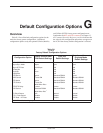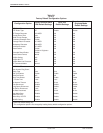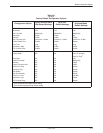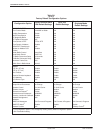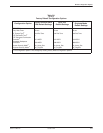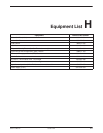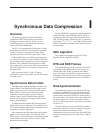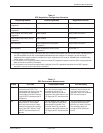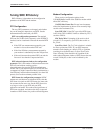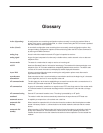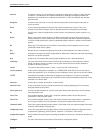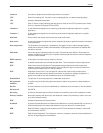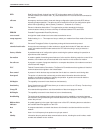
I-13980-A2-GB30-40 October 1998
Synchronous Data Compression
Overview
The Paradyne proprietary Synchronous Data
Compression (SDC) feature allows an increase of
throughput in data transmission, and has an error
correcting procedure so that transmitted data is less
sensitive to channel disturbances.
The ITU-T recommendations V.42bis and V.42 have
data compression and error correcting (EC) procedures
for DCEs connected to asynchronous DTEs. These
procedures form the basis of Paradyne’s SDC feature.
With the SDC feature, two DTEs can exchange data
via a synchronous protocol while the DCE provides the
new synchronous data compression and error correction
functions. The synchronous data from the local DTE,
after compression, is inserted into DCE frames which are
sent to the remote DCE. Inverse operations then occur at
the remote DCE.
SDC can be used with V.34 and V.32 family
modulations on dial or leased lines, and in a dial backup
or standby mode.
Synchronous Data Format
The SDC feature supports the High-level Data Link
Control (HDLC) and Synchronous Data Link Control
(SDLC) type protocols for synchronous DTE data. An
HDLC frame is composed of an information field
containing the data to transmit, plus an overhead
(address, control, and FCS fields) used by the DTE
protocol. Flags opening and closing the HDLC frame
serve as frame delimiters.
A 3800Plus modem with the SDC feature supports
DTE frame sizes up to 4300 bytes. This conforms to the
X.25 recommendation which defines a maximum size of
data packets as equal to 4096 bytes.
If the modem has the SDC Delay Min configuration
option set to Rx_Clock, there is no limitation on the
DTE frame size for the DTE frames transmitted from the
remote modem to this local modem, since the whole
frame need not be buffered.
The SyncDTE CRC configuration option determines
whether the CRC of the DTE frame (the FCS field) is
transmitted. If the CRC type is known to be the 16-bit
CRC for HDLC frames as defined by ITU-T (generator
polynomial x
16
+ x
12
+ x
5
+ 1), the CRC can be removed
by the local modem and added to the DTE frame by the
remote modem.
SDC Algorithm
The compression algorithm is based on V.42bis
British Telecom Lempel ZIV (BLTZ).
DTE and DCE Frames
Data exchanged between the local and remote DCEs
is according to the LAPM protocol. The structure of a
LAPM frame (DCE frame) is identical to the HDLC
frame. The data from the DTE is compressed into the
information field of the DCE frame. After compression,
one DTE frame is segmented into one or several DCE
frames.
Data Synchronization
Data exchanged between the synchronous DTE and
the modem is synchronized by two clock signals. Data
coming from the DTE is synchronized by the transmit
clock and data received by the DTE is synchronized by
the receive clock. The transmit clock is provided by the
modem on circuit 114 or by the synchronous DTE on
circuit 113. The receive clock is provided by the modem
on circuit 115.
When the transmit clock is provided by the modem,
the transmit and receive clocks are locked on the same
clock source internal to the modem. In this
configuration, the user can select rates on the DTE-DCE
line (or clock frequencies) in the range from 1.2 kHz to
128 kHz.
I



